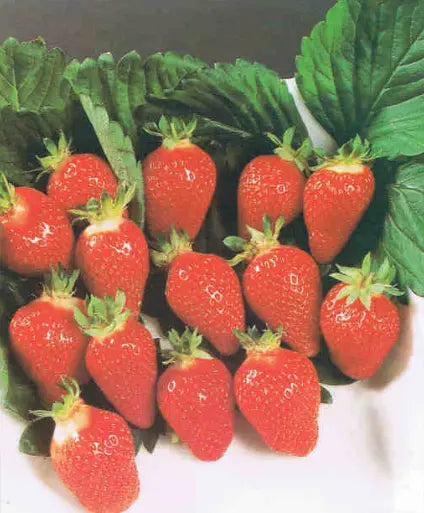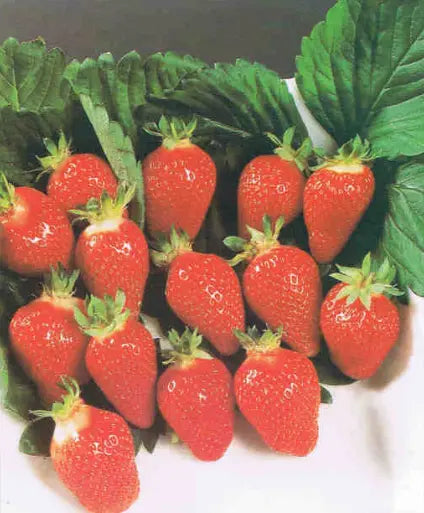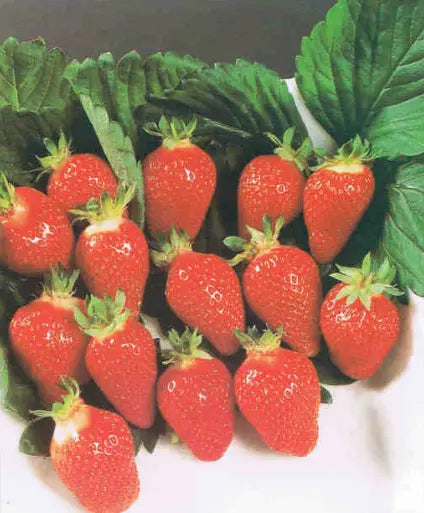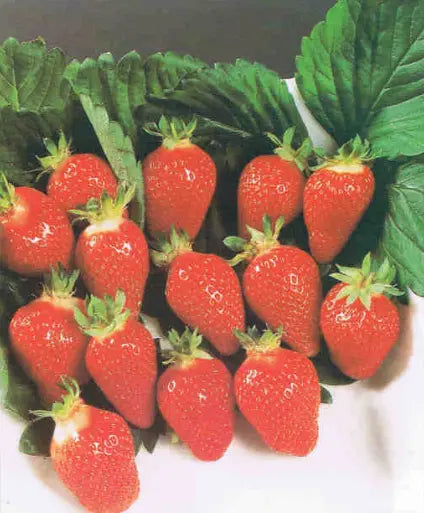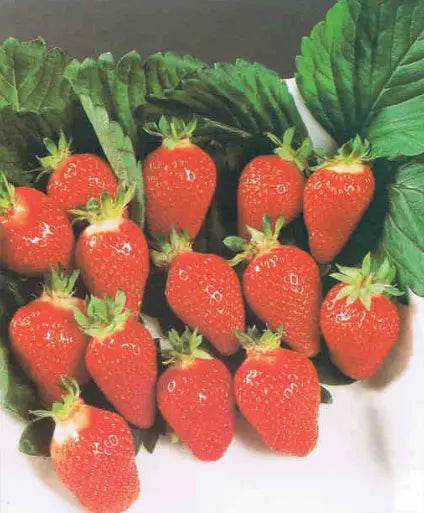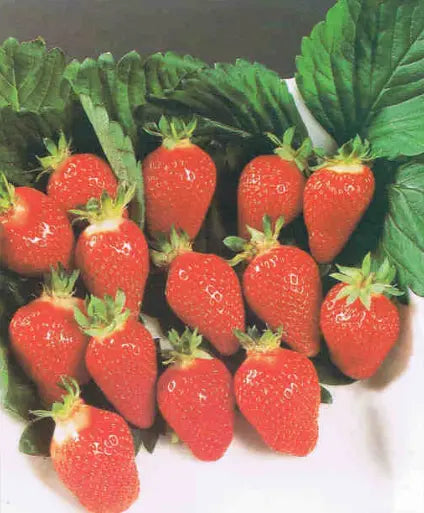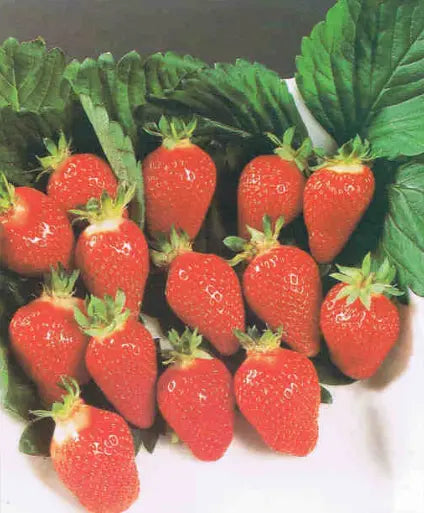Our Cireine Strawberry plants at producer prices
Buy now and get it delivered when you're ready to plant
-
Cireine Frigo A Strawberry Plant for Individuals
Regular price €0,58 EURRegular priceUnit price / per -
Cireine Frigo A+ Strawberry Plant - Buy Now Online for Professionals
Regular price €0,42 EURRegular priceUnit price / per -
Cireine Frigo B Strawberry Plant
Regular price €0,26 EURRegular priceUnit price / per -
Cireine Frigo B Strawberry Plant - Buy Now Online for Professionals
Regular price €0,26 EURRegular priceUnit price / per -
Cireine Fresh Bare-Root Strawberry Plant - Buy Now Online for Professionals
Regular price €0,36 EURRegular priceUnit price / per -
Cireine Frigo A Strawberry Plant - Buy Now Online for Professionals
Regular price €0,36 EURRegular priceUnit price / per -
Cireine Fresh Bare-Root Strawberry Plant
Regular price €0,20 EURRegular priceUnit price / per -
Cireine Frigo A+ Strawberry Plant
Regular price €0,23 EURRegular priceUnit price / per -
Cireine Frigo A Strawberry Plant
Regular price €0,20 EURRegular priceUnit price / per
Collapsible content
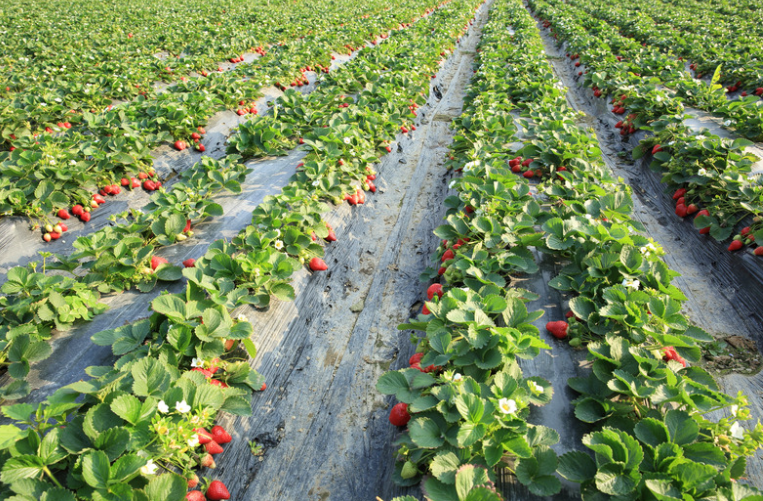
Strawberry Plant Buying Guide: What Type of Plants? For What Market Opportunity?
Which format should you choose: refrigerated, fresh, tray-plants, waiting bed, or plugs? Compare yields, costs, and harvest times at a glance.
Download the PDF guide (13 pages)
Why read this guide?
- Comparison tables: yield (300–600 g/plant), cost & labor.
- Reservation/delivery calendar for each format.
- Minimum order: 20 to 1,000 plants depending on the type.
- Full-field vs. above-ground case studies to maximize margin.
Overview of the 5 professional formats
Detailed comparison of formats
| Format | Yield (g/plant) |
Harvest time | Min. order | Average cost |
|---|---|---|---|---|
| Fridge | 250 – 400 | 120 days | 20 plants | 0.20 – 0.45 € |
| Costs | 280 – 420 | 140 days | 200 plants | 0.20 – 0.45 € |
| Tray plant | 400 – 600 | 90 days | 500 plants | 0.75 – 0.80 € |
| Waiting Bed | 300 – 500 | 105 days | 500 plants | 0.50 – 0.60 € |
| Motte | 230 – 350 | N+1 | 1,000 plants | 0.35 – 0.50 € |
Delivery schedule
| Plant type | Jan | Feb | Mar | Apr | May | Jul | Jul | Aug | Sep | Oct | Nov | Dec |
|---|---|---|---|---|---|---|---|---|---|---|---|---|
| Fridge | ||||||||||||
| Tray plants | ||||||||||||
| Waiting Bed | ||||||||||||
| Motte | ||||||||||||
| Costs |
Which format for which scenario?
Full field controlled budget
Fridge or Fresh : cost 2 x lower than tray plants, planting flexibility.
Above ground in greenhouse
Tray-plants : harvest 90 days after planting, uniform size, reduced labor.
Late planting
Mottes : planting July–August, rapid recovery, harvest the following year.
Ready to plan your plantings?
Download the complete guide Request a quoteFrequently Asked Questions
Is the guide free?
Yes, no fees or obligation to purchase.
How to download it?
Click the button “Download the guide” ; the PDF opens immediately.
Can I request a personalized quote?
Of course: write to us at contact@fraisiverse.com and an agronomist will respond to you within 24 hours.
Choosing the right strawberry varieties for your plot
Extend your harvest season by up to 5.5 months with our "early + season + everbearing" method. Compare 78 cultivars, sizes, and markets.
Download the PDF guide (17 pages)
4 axes to decide quickly
- Harvest Window : Early, Seasonal, or Everbearing? Combine them for 5.5 months .
- Commercial outlet : direct sales, long circuit, processing or freezing.
- Type of plants : fridge, fresh, root ball, tray plants… adapt your investments and your schedule.
- Growing conditions : open field, soilless, greenhouse; target consistent yield and size.
Axis 1: Select your harvest window
Example of recommended mix:
- Ciflorette (early) → Rubis des Jardins (season) → Charlotte (remontant).
- 5.5 months of continuous production, ideal for direct sales.
Axis 2: Sell at the right market
Direct sales
Ciflorette, Charlotte, Mara des Bois: premium taste sought after by consumers.
Long circuit / GMS
Magnum, Clery, Dream: uniform size, 95% class 1 fruit.
Transformation
Darselect, Mara des Bois – high sugar content and stable aroma.
Freezing
Honeoye, Belrubi – firm flesh, keeps well in the cold.
Axis 3: Choose the right type of plants
| Kind | Reservation | Delivery | Highlights |
|---|---|---|---|
| Fridge | All year round | Dec. → Aug. | Flexibility & price |
| Tray plants | Feb. → June | Nov. → Apr. | Above ground, harvest 90 days after planting |
| Motte | Sep. → May | Jul. → Sep. | Ideal for open fields, harvest N+1 |
| Costs | Feb. → Aug. | Sep. → Nov. | Young plants, rapid recovery |
Axis 4: Optimize your technical constraints
Tray plants guarantee +25% yield and simplified harvesting above ground; ideal for mechanizing your production and ensuring consistent size.
Frequently Asked Questions
Is the guide really free?
Yes, with no cost or obligation to purchase.
How to download it?
Just click the button “Download the guide” at the top of the page; the PDF opens immediately.
Can I request a personalized quote?
Of course: contact us via our contact page .
When to plant? When to harvest?
Do you want to start a strawberry farm but don't know when to reserve your plants, when to plant them or even harvest them?
Because we love 🍓 (with just a little sugar), we're going to do the work for you. On this page, you'll find the growing steps for each type of strawberry plant. When to order? What is the delivery period? When to plant? And finally, when to harvest?
Production Calendar - Frigo Strawberry Plants
| Production Calendar - Frigo Strawberry Plants | ||||||||||||||||||||||||
|---|---|---|---|---|---|---|---|---|---|---|---|---|---|---|---|---|---|---|---|---|---|---|---|---|
| Jan | Feb | Mar | Apr | May | Jun | Jul | Aug | Sep | Oct | Nov | Dec | |||||||||||||
| Reservation | ||||||||||||||||||||||||
| Deliverable | ||||||||||||||||||||||||
| Recommended planting | ||||||||||||||||||||||||
| Harvest | ||||||||||||||||||||||||
Production Calendar - Fresh Bare-Root Strawberry Plants
| Production Calendar - Bare Root Strawberry Plants | ||||||||||||||||||||||||
|---|---|---|---|---|---|---|---|---|---|---|---|---|---|---|---|---|---|---|---|---|---|---|---|---|
| Jan | Feb | Mar | Apr | May | Jun | Jul | Aug | Sep | Oct | Nov | Dec | |||||||||||||
| Reservation | ||||||||||||||||||||||||
| Deliverable | ||||||||||||||||||||||||
| Recommended planting | ||||||||||||||||||||||||
| Harvest | ||||||||||||||||||||||||
Production Calendar - Strawberry Plants Plugs
| Production Calendar - Strawberry Plants Motte | ||||||||||||||||||||||||
|---|---|---|---|---|---|---|---|---|---|---|---|---|---|---|---|---|---|---|---|---|---|---|---|---|
| Jan | Feb | Mar | Apr | May | Jun | Jul | Aug | Sep | Oct | Nov | Dec | |||||||||||||
| Reservation | ||||||||||||||||||||||||
| Deliverable | ||||||||||||||||||||||||
| Recommended planting | ||||||||||||||||||||||||
| Harvest | ||||||||||||||||||||||||
Production Calendar - Strawberry Plant Tray
| Production Calendar - Strawberry Plants Motte | ||||||||||||||||||||||||
|---|---|---|---|---|---|---|---|---|---|---|---|---|---|---|---|---|---|---|---|---|---|---|---|---|
| Jan | Feb | Mar | Apr | May | Jun | Jul | Aug | Sep | Oct | Nov | Dec | |||||||||||||
| Reservation | ||||||||||||||||||||||||
| Deliverable | ||||||||||||||||||||||||
| Recommended planting | ||||||||||||||||||||||||
| Harvest | ||||||||||||||||||||||||
Our Growing Guides by Plant Type / Our Growing Tips
Our online advisor: Fraisibot
Our technical itineraries by type of strawberry plant:
Technical Itinerary for Growing Strawberries from Frigo Plants
Technical Itinerary for Growing Strawberries from Plug/Pod Plants
Technical Instructions for Growing Strawberries from Tray or Mini Tray Plants
Technical Guide for Growing Strawberries from Bare-Root Fresh Strawberry Plants
Technical Instructions for Growing Strawberries from Waiting Bed Plants
All our growing tips for planting strawberries:
Strawberry Plants: Soil Preparation and Planting
Soil preparation for strawberry growing, planting techniques, and optimizing strawberry yield.
Best Practices for Irrigation and Fertilization of Strawberry Plants
Efficient irrigation systems, frequency and quantity of watering, types of fertilizers and application times, signs of nutritional deficiencies, growing strawberries in substrate, protection against frost and diseases.
Protection and Prevention of Strawberry Diseases and Pests
The main diseases and pests affecting strawberries, as well as effective methods for their prevention and treatment, including biological control and the use of resistant varieties. It provides practical advice for maintaining healthy and productive strawberry crops.
Succeeding in Strawberry Farming: Costs, Business Strategy and Subsidies
Growing strawberries requires significant initial and ongoing costs, but with effective marketing strategies and sustainable practices, growers can maximize their profits while contributing positively to the environment. Grants and financial aid are available to support necessary investments and encourage environmentally friendly farming practices.
Maximizing Strawberry Harvest and Storage: A Practical Guide
How to determine the optimal time to harvest strawberries, best practices for minimizing fruit damage during picking, and effective methods for storing and managing unsold strawberries to avoid losses and maximize profitability. It offers practical tips for extending the shelf life of strawberries, including refrigeration, freezing, and dehydration.
Strawberry Growing: Why Stagger Production? Early, Seasonal, Late? How to Choose?
Staggering strawberry production allows for harvests to be spread throughout the season, ensuring optimal fruit quality and increased profitability. Learn about recommended varieties for early, mid-season, and late-season production, as well as best practices for harvesting and storage.
-
Delivery from 10 plants to France, Switzerland and Europe
Delivery methodWe deliver anywhere in France as quickly as possible. Cost/quality balance is our priority.
-
Strawberry Plant Wholesale Supplier
About UsWe work with dozens of producers to offer you the best prices.
-
Quality Strawberry Plants
Strawberry Technical ItinerariesOur producers are selected for their reliability and the quality of their products.
-
Collection: Our Cireine Strawberry plants at producer prices
Technical sheet for the Cireine strawberry variety
- Remontant: Non-Remontant
- Precocity: Mid-Early
- Harvest period: June to early August
- Shape, texture, appearance of the Fruit: Round Fruits
- Fruit color: Shiny
- Taste characteristics: Quite fragrant, good sugar/acid balance
- Fruit Size: Quite Fragrant, Good Sugar/Acid Balance
- Disease Resistance: Highly disease resistant
- Performance, Management and Marketing: High Performance
- Recommended commercial use / marketing channel: Direct sales, Wholesale, Processing
Order your professional strawberry plants
Fraisiverse , a specialist wholesale supplier of strawberry plants , offers you the Cireine variety to meet the requirements of professional growers. Buying your strawberry plants guarantees you direct access to high-quality plants, produced by specialized nurseries. This choice ensures professional quality , appreciated varietal resistance , high yield , as well as increased tolerance to diseases . Our producer prices and decreasing prices are designed to optimize your profitability. You benefit from dedicated technical support and a responsive sales department , with fast and careful delivery throughout France . To refine your cultivation strategy, take advantage of our personalized advice . Order now or request your free quote to guarantee your Cireine plants for the next campaign.
Agronomic Characteristics and Varietal Description
The Cireine strawberry plant is a non-remontant variety , meaning that it produces a single major harvest per season, concentrated over a defined period, an asset for planning professional harvests. This variety is distinguished by its precocity , placing itself in the category of early strawberry plants whose fruit ripens from June and can extend until the end of July.
The plant itself displays remarkable vigor , characterized by an upright habit and airy foliage, reaching an average height of 35 to 40 centimeters . This architecture not only facilitates cultivation, but also contributes to better aeration of the plant, a key factor in health management.
Morphology and Organoleptic Qualities of the Fruit
As for the Cireine fruit, it is unanimously appreciated for its appearance and its taste qualities. Of a generous size, Cireine strawberries typically weigh between 20 and 25 grams at commercial maturity . Their shape is elongated to biconical, of remarkable regularity, highlighting the homogeneity of the production. The epidermis displays a bright, brilliant red, very shiny , guaranteeing an exceptional visual presentation on the stalls. The flesh, meanwhile, is light to light red, firm and juicy, a perfect balance for fresh consumption.
In terms of taste, Cireine is a sweet and very fragrant fruit, enhanced by a slight hint of acidity which gives it a highly sought-after balance in the mouth. Professional tasting tests give it a score of 4/5 for its crunchiness and 3/5 for its juiciness , with an overall rating of A-. This performance positions it favorably compared to reference varieties such as Sonata or Annabelle for texture and perceived quality.
Technical Protocols for Cultural Conduct
Cireine strawberry cultivation adapts to various professional methods, including open-field cultivation and high-density soilless cultivation , whether in overlapping gutters or on substrate bags. Cireine's natural resistance to disease reduces the risks inherent in the high concentration of plants in these intensive systems.
Pedo-Climatic Requirements and Optimal Conditions
For optimal growth, the Cireine strawberry plant thrives ideally in sunny to partially shaded conditions, in rich, well-drained soil . In soilless cultivation, management of the nutrient solution is essential.
Fertigation Management and Electrical Conductivity
General technical recommendations for strawberries suggest an optimal electrical conductivity (EC) of the nutrient solution between 1.0 and 1.5 mS/cm during the vegetative growth phase , and an increase to 1.4-1.8 mS/cm during fruiting . It is crucial not to exceed an EC of 1.8 to 2.0 mS/cm for Cireine to avoid any yield loss or deterioration of fruit quality, a value that is in line with the standards of large-fruited, high-yielding varieties.
Planting Density and Cultural Development
Regarding the planting density in high-density soilless systems, although the source does not provide specific figures for Cireine, it is usual for most modern and productive varieties to aim for a density of 12 to 14 plants per square meter or 8 to 14 plants per linear meter , with a substrate volume of approximately 1 to 1.25 liters per plant . Careful monitoring of substrate salinity and drainage is imperative, particularly under high temperatures or during significant fertilizer applications.
Yield and Harvest Planning
As a non-remontant variety, Cireine concentrates its production in a single, intense period. Harvest begins in June and continues until the end of July . Approximately 70% of Cireine production occurs in a 3- to 4-week window , typically between mid-June and mid-July, which corresponds to weeks 24 to 27 of the calendar . Peak harvest is often observed between weeks 25 and 27.
Productive Performance and Commercial Calibration
Available information describes Cireine's yield as "high" . Professional feedback indicates that between 80% and 90% of the harvested fruit is first category (Class I) at the time of packaging, which guarantees an excellent marketable yield. Therefore, the percentage of waste (downgraded, damaged or poorly sized fruit) generally remains between 8% and 15% under optimized growing conditions.
In terms of uniformity, Cireine is particularly appreciated for the very good homogeneity of size of its fruits, which maintain a constant size of around 20 to 25 grams at the heart of the harvest , thus facilitating sorting and packaging operations. An indicative figure for non-remontant strawberry plants of this type of production is a yield of around 1.5 kg/m² .
Phytosanitary Protection and Pest Management
One of the major advantages of the Cireine variety is its excellent resistance to disease . This characteristic is a determining factor for professionals, as it helps to limit the use of phytosanitary treatments and to secure production.
Varietal Resistance and Documentary Gaps
However, it is important to note that specific information on the level of resistance of Cireine to major diseases such as botrytis, powdery mildew (Podosphaera aphanis), anthracnose, phytophthora (red crown) or verticillium wilt is not detailed in the sources consulted. Similarly, for common strawberry pests such as thrips, aphids, spider mites, weevil (Anthonomus) or Drosophila suzukii , no quantified data or specific studies on the intrinsic resistance of Cireine are publicly available.
Integrated Pest Management Strategies
Therefore, as with the majority of strawberry varieties grown professionally in France, the management of these pests for Cireine is mainly based on the application of prophylactic methods, biological control (introduction of auxiliaries such as ladybugs or predatory mites), and, if necessary, targeted and reasoned chemical interventions. It is therefore necessary to maintain active monitoring of plots and adapt control strategies according to the observed pest pressure.
Profitability and Commercial Opportunities
The Cireine variety offers attractive profitability for professionals thanks to its commercial versatility and the intrinsic quality of its fruits. It is primarily intended for fresh consumption , a market where its large fruits (20 to 25 g), their sweet and fragrant taste, as well as their shiny appearance are particularly valued. This positioning is ideal for direct sales, short circuits and retail markets where freshness and organoleptic quality are paramount.
Applications in Processing and Food Industry
Beyond fresh consumption, Cireine is also very well suited to processing, particularly for making jams, jellies and syrups . Its good yield, suitable texture and strong aroma make it a relevant choice for artisans or semi-industrialists. Freezing is also a possible option, as the fruits retain their texture and flavor well after thawing. Use in mass agro-industry is possible, although less of a priority, Cireine being more popular for short circuits or local processing.
Supply Logistics and Production Costs
For professionals, the supply of Cireine plants is facilitated by a competitive price range, varying from €0.20 to €0.58 per plant depending on the size and delivery terms. This pricing flexibility, combined with the robustness of the plants, supports supply logistics for large or small farms. The consistent quality of the fruit and the high percentage of marketable fruit (80-90%) contribute to optimizing the financial return of the harvest.
Feedback and Professional Assessment
Growers who have incorporated the Cireine variety into their crops unanimously highlight its distinctive qualities. Its crisp texture and balanced, sweet and slightly tangy taste make it a strawberry highly appreciated by consumers, a strong selling point on fresh markets. The large size and uniformity of the fruit are also frequently cited strengths, facilitating harvesting and packaging operations.
Cireine's adaptability to soilless cultivation , combined with its general robustness against diseases, is seen as a major asset for securing production and controlling health risks, particularly in intensive cultivation systems. Feedback confirms that Cireine is positioned as a variety with assured taste value , at a level comparable to, or even superior to, established references for organoleptic quality and mouthfeel. This positive reputation among professionals reinforces its legitimacy on the plant and fruit market.
To summarize: Our Cireine strawberry plants
By choosing Cireine strawberry plants offered by Fraisiverse , you are investing in a variety known for its precocity, its regularity of size and its exceptional organoleptic qualities. Productive and resistant, Cireine is suitable for professional cultivation both in open fields and in high-density soilless cultivation. Its concentrated harvest period, from mid-June to mid-July, facilitates planning and optimizes labor. The variety has a high yield , with 80 to 90% of category I fruits and a consistent size of 20 to 25 g, ideal for direct sales and short supply chains. As a wholesale supplier specializing in strawberry plants , Fraisiverse supports you with certified plants, delivered throughout France. Thanks to our expertise, you can buy Cireine strawberry plants with complete confidence. Benefit from competitive prices, reliable logistics and technical support adapted to your needs. Whether you're looking for fresh consumption or artisanal processing, Cireine adapts to your needs. As a specialist wholesale supplier of strawberry plants for several years, we offer plants from carefully selected nurseries. Buying Cireine strawberry plants guarantees consistent harvesting and excellent post-harvest performance. Trust Fraisiverse , your specialist wholesale supplier of strawberry plants , to buy Cireine strawberry plants with peace of mind, performance, and consistency.
Fraisiverse - Your supplier of quality strawberry plants. Organic or conventional. Delivery throughout France. Wide range of strawberry plants: Tray Strawberry Plants, Motte Strawberry Plants, Frigo Strawberry Plants, Waiting Bed Strawberry Plants. Strawberry plants for professional and private strawberry growers

